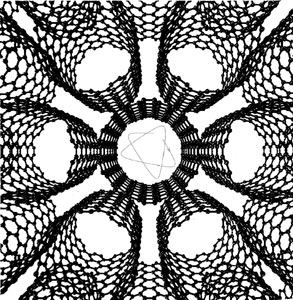New types of materials suggest new ways of handling high-energy particle beams, but can carbon nanotubes handle high-energy particles? Specialists from Yerevan outline the possibilities.

Nanoparticles are small pieces of matter that, at least in one dimension, consist of tens to thousands of atoms and have widths of the order of a few nanometres. Nanotechnology – the production, study and application of nanoparticles – could be set to play a major role in technological development.
Carbon nanotubes are typical nanoparticles, which were first produced in 1991 after the 1985 discovery of large football-like “fullerene” molecules of pure carbon-60 atoms that are found in the sediments from the laser irradiation of graphite.
Nanotubes can be imagined as rolled-up graphite crystallographic planes with carbon atoms separated by 1.3 nm at the vertices of honeycomb hexagons. Nanotubes are either concentric multiwalled (MWNT) or single-walled (SWNT) structures. The latter are characterized by two numbers, n and m, which determine not only the diameter and geometry, but also many physical parameters, such as the metallic or semiconductor nature.
In 1996 it was shown that the metallic SWNTs with n=m=10 are produced with 75% efficiency in the sediment of graphite after laser irradiation. SWNTs have a length of up to 200 µm and a diameter of 1.38 nm, and a few hundred of them form compact ropes with 17 nm between the axes.
The unique properties of MWNTs and SWMTs promise wide application in various fields of industry and science. Owing to their smaller size, nanotube chips could replace transistors in electronic devices, providing higher densities of logic units. With their more effective field emission of electrons, they could be better than liquid crystals in advertisement, electronic and television displays.<textbreak=Channelling>In addition to other possible developments, during 1996-1997 V V Klimov, V S Lethokhov, L A Gevorgian and we considered the theory of the channelling of high-energy particles in SWNTs. (In conventional channelling, charged particles are steered by the electromagnetic forces in crystals.)

The fact that the diameter of SWNTs is larger than the distances between the crystallographic planes, and the possibility that, in the near future, nanotubes will be available in lengths greater than single crystals, underline the potential advantage of nanotubes.
Indeed, the much lower SWNT electron density results in a sharp decrease in multiple scattering. As a result, the channelling protons and positrons moving near the SWNT axis suffer less dechannelling.
The classical and quantum theories of the radiation of particles channelled in SWNT, which are valid for energies both above and below about 100 MeV respectively, demonstrate that, taking into account medium polarization, X-ray production has specific threshold and spectral properties, and it can also serve as a source of intense quasimonochromatic photon beams. Periodically deformed nanotubes as microundulators can provide intense linearly and circularly polarized spontaneous and stimulated radiation in the X-ray region.








